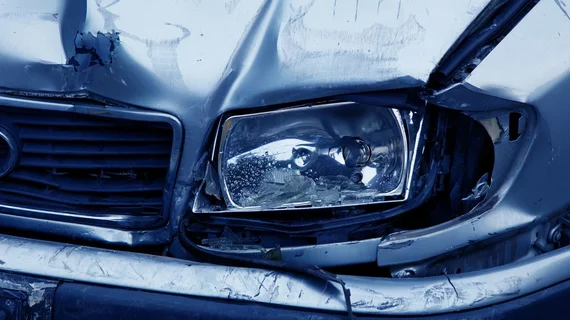Whole-body CT not always warranted for motor vehicle crash victims
Whole-body CT should not be routinely performed for patients who have been involved in a high-impact motor vehicle crash but show no signs or symptoms of internal injury on physical examination, according to the authors of a study published Tuesday in Radiology.
“Whole-body CT is responsible for a higher amount of radiation dose delivered to patients,” wrote lead author Dihia Belabbas, MD, department of radiology, University Hospital of Rennes in Rennes, France, and colleagues. “In view of the known risks of injected CT (radiation exposure, renal and allergy risks, time and cost), debate continues about the risk-to-benefit ratio of systematic whole-body CT when no injury is clinically suspected.”
In France, according to the researchers, indications for whole-body CT are based on the Vittel criteria. These criteria include physiologic variables, kinetic components (ie, mechanism of injury), anatomic injuries and resuscitation prior to admission. The researchers hypothesized that following a motor vehicle crash, the probability of serious injury is so low that there is no need to perform whole-body CT on a patient when only a kinetic element (ie, related to the mechanism of injury) of the Vittel criteria is present, the patient’s Glasgow Coma Scale score is 15 (indicating mild injury) and physical examination of the trunk is normal.
Belabbas et al conducted a retrospective study involving 93 motor vehicle crash victims assessed in the emergency department of a level one trauma center between August 2016 and July 2017. Of these patients, 69 had been in a car at the time of the crash. Seventeen patients had been hit by a car while on a motorbike; three, while riding a bicycle and four, as pedestrians. All patients had undergone whole-body CT for one or more kinetic elements of the Vittel criteria, displayed no abnormalities of the trunk upon examination and had a Glasgow Coma Scale score of 15. Data pertaining to the motor vehicle crash mechanism, as well as to physical and biologic examinations, were collected, along with post whole-body CT patient treatment data. Two double-blinded readers read the whole-body CT studies to help detect unsuspected injuries.
Eleven whole-body CT examinations revealed unsuspected injuries, including eight lung contusions, one acetabular fracture, one sternal fracture and one adrenal hematoma. None of these injuries was deemed to require specific treatment. One patient with lung contusion of more than 30% of lung volume was followed without requiring further treatment.
“When only a kinetic element of the Vittel criteria (is) present for patients following a motor vehicle crash, whole-body CT may not need to be systematically performed (if) no clinical trunk or laboratory abnormalities are identified,” the researchers concluded. “Clear guidelines for treatment of these patients may have a positive impact on patient triage in.. emergency and radiology departments.”
